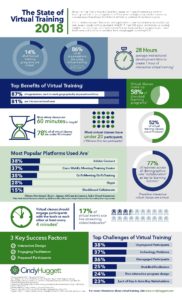Keeping up with trends in workplace learning is of interest to many people, myself included. In 2014’s The Virtual Training Guidebook, I predicted three future trends for virtual training. Last year, in Virtual Training Tools and Templates, I weighed in on those trends and made some additional predictions. As part of my continued quest to stay on top of the trends, I conducted my own research study in mid-2017.
I surveyed global training professionals – including many of my current and former clients – to ask about virtual training in their organizations. A total of 330 people responded (thank you!) and shared their insights.
In addition to the survey data I collected, I searched for and compiled key virtual training statistics from several readily  available industry reports. My curated summary can be seen in this infographic, which is also available for download.
available industry reports. My curated summary can be seen in this infographic, which is also available for download.
Here are several highlights from my findings:
Virtual Training continues to grow
Virtual training isn’t new. I designed and facilitated my first virtual training classes back in the early 2000s. Many of the interactive tools and techniques I used in that first blended curriculum are still the tools and techniques I use today.
Yet, new technologies, new collaboration tools and new ways of working mean that virtual training continues to evolve and grow. According to Training Magazine’s 2017 Industry Report, 14% of all formal training hours are offered in the virtual classroom. This number has doubled over the past decade and is expected to continue to rise.
Virtual Training classes are getting shorter
A 2012 eLearning Guild research report reported that the typical length of a virtual class was 90 minutes. According to my 2017 research, classes are getting shorter, with 60-minute sessions as the most popular length. While some virtual classes are longer, 78% of them are less than 90 minutes.
When looking at this number, it’s also important to note that it’s rare to find a virtual event in isolation. In other words, most virtual classes are components of a larger training curriculum. According to a 2013 report by the Chapman Alliance, virtual classes make up 58% of all blended learning programs. (I haven’t yet found more current research on this number, so if you are aware of any, please comment below!)
In addition, most virtual training classes are offered to small groups. My research revealed that 79% of all classes have 25 or less participants. This parallels my experience with traditional in-person classes, which usually have small numbers.
Virtual Training expands reach of learning programs
One reason organizations implement virtual training is to save on costs, but surprisingly that’s not the most common reason. According to ATD’s 2016 research report, Virtual Classrooms Now: Using Technology to Reach Today’s Workforce, the number one reason organizations adopt virtual training is to expand offerings to reach a geographically dispersed workforce.
Virtual Classroom Platforms are evolving
One of the most common questions I’m asked is “Which virtual classroom platform should we use?” My answer is always “it depends.” The best solution for one organization isn’t necessarily the best solution for every organization. In my 2017 research study, I simply asked the question “which platforms do you use?”
Of interesting note, many organizations are using platforms designed for online meetings instead of online training classes. It may work but is not an ideal solution. Virtual classroom platforms typically offer more interactive tools and features for learning (such as breakout rooms).
Virtual Training has challenges
Another question I asked in my research study is “What’s your biggest virtual training challenge? What gets in the way of your success?” Survey respondents didn’t shy away from sharing their challenges. This was an open-ended question, so I categorized the comments and distilled down the topics mentioned. (That’s why the numbers don’t tally up to 100%). For example, the response “participants were challenged by technology” and “Our users lack of technical skills” were both included in the “Unprepared Participants” category. While “Keeping people engaged” and “Participants multitasking” both placed into the “Unengaged Participants” category.
My two observations on these challenges are as follows. One the one hand, we can take comfort in knowing that many other organizations struggle with similar challenges. But on the other hand, all of these challenges can be overcome. Several of my resources are designed to help, and I’m planning to do some follow up blog posts on each of the challenges. Stay tuned for more information.
Virtual Training can be successful
Turning our attention to what makes successful virtual training? In my experience, it takes three key items. First, an interactive design that keeps participants involved. Virtual classes should engage participants with the tools and/or each other approximately every 4 minutes. Participants want to engage and collaborate. Second, we need skilled facilitators who focus on creating dialogue, creating a comfortable environment, and applying adult learning principles. Finally, prepared participants hold the third key to success. We need to educate them on how to learn online, set expectations for interaction, and equip them with skills needed to use the platform.
_______________
Now over to you. Which of these trends are true in your organizations? How do your virtual training classes compare? Please enter your thoughts in the comments below.



1 Comment